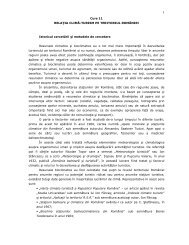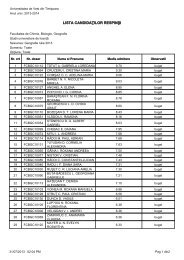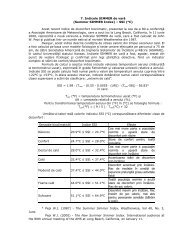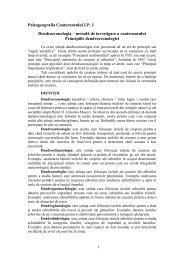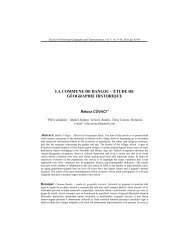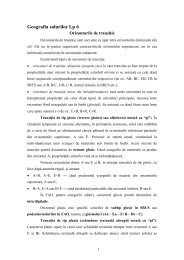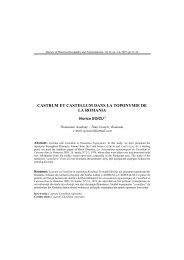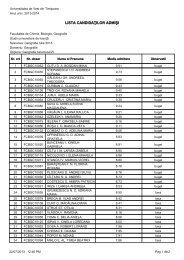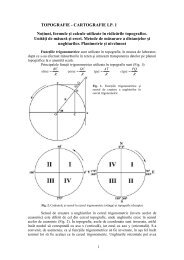drobeta turnu severin - Departamentul de Geografie
drobeta turnu severin - Departamentul de Geografie
drobeta turnu severin - Departamentul de Geografie
You also want an ePaper? Increase the reach of your titles
YUMPU automatically turns print PDFs into web optimized ePapers that Google loves.
Review of Historical Geography and Toponomastics, vol. V no. 9-10, 2010, pp. 97-106<br />
DROBETA TURNU SEVERIN:<br />
A GEO-HISTORICAL EVOLUTION<br />
Mădălina PĂUNESCU Marian BUTUŞINĂ**<br />
* Teacher, Şimian Secondary School, Mehedinţi County, Romania,<br />
e-mail: madalina_paunescu @yahoo.com<br />
** Teacher, Economic College "Theodor Costescu", Drobeta Turnu Severin,<br />
Romania, e-mail: marianbutusina@yahoo.com<br />
Abstract: Drobeta Turnu Severin: A Geo-Historical Evolution. The remote times since the history<br />
of the town lasts transformed its territory into a huge outdoor museum. On these lands, the country’s<br />
first Romanian rulers stepped and fulfieled their interests. From here Mircea the El<strong>de</strong>st prepared the<br />
crushing of the enemy armies. Early glorious reigns of Michael the Brave and Carol I happened in<br />
this holy place of Romanian origin. Here was the original territory of permanent and original<br />
synthesis of culture and civilization, which were imposed by the diligence and the skill of the people,<br />
by the beauty and richness of the places. Between the city and the Danube there was always a very<br />
close link because the river gave specific character and brought economic prosperity to the city. When<br />
we visit the Roman castrum we feel special emotions because we know that through this castrum felt<br />
stepped emperors like Septimius Severus and Trajan or Domitian. Mircea the El<strong>de</strong>st, Mihail<br />
Kogalniceanu and I. Bratianu felt as we feel pri<strong>de</strong> and a sense of belonging to this earth.<br />
Rezumat: Drobeta Turnu Severin: o evoluţie geo-istorică. Din timpuri în<strong>de</strong>părtate, <strong>de</strong> când<br />
datează istoria acestui oraş, i-a transformat teritoriul într-un muzeu în aer liber. Pe aceste meleaguri,<br />
primii conducători ai României şi-au urmărit treptat interesele. De aici, Mircea cel Bătrân a pregătit<br />
zdrobirea armatelor inamice. Glorioasa domnie a lui Mihai Viteazul şi Carol I a avut loc în acest loc<br />
sfânt al României. Aici a fost teritoriul original al culturii şi civilizaţiei impuse <strong>de</strong> diligenţă şi <strong>de</strong><br />
calificarea oamenilor, <strong>de</strong> frumuseţea şi bogăţia locurilor. Între oraş şi Dunăre a fost întot<strong>de</strong>auna o<br />
strânsă legătură <strong>de</strong>oarece fluviul i-a atribuit un caracter specific şi a adus prosperitate economică<br />
oraşului. Când vizităm castrul roman simţim emoţii <strong>de</strong>osebite <strong>de</strong>oarece ştim că urmele sale fac<br />
referire la împăraţi precum Septimius Severus şi Traian sau Domiţian. Mircea <strong>de</strong>l Bătrân, Mihail<br />
Kogălniceanu şi I. Brătianu ne măresc sentimentul <strong>de</strong> mândrie al apartenenţei acestui ţinut.<br />
Key words: geo-historical evolution, Drobeta Turnu Severin.<br />
Cuvinte cheie: evoluţie geo-istorică, Drobeta Turnu Severin.
Mădălina PĂUNESCU, Marian BUTUŞINĂ<br />
1. INTRODUCTION<br />
Severin city has a historic rise which loses its inception in the mists of time. Its<br />
<strong>de</strong>stiny is a direct result of its geographical position in the western part of Oltenia with the<br />
center placed on the coordinates 22 0 33 'east longitu<strong>de</strong> and 44 0 38' north latitu<strong>de</strong>, on the<br />
left bank of the Danube River at the leaving of the narrow strait in the Carpathian basin of<br />
the Topolniţa on the European Road 70. The romote times since the history of the town<br />
lasts transformed its territory into a huge outdoor museum.<br />
A history philosopher says that a city becomes a community in itself, with selfawareness,<br />
primarily through its history, because history enhances its personality. The<br />
Roman encampment or the foot bridge of Traian remind us of our forefathers of this<br />
nation and we are overwhelmed by special feelings because we know that through this<br />
encampment stepped Emperor Trajan, Septimius Severus and Domitian.<br />
2. A GEO-HISTORICAL ANALYSIS SINCE THE ANCIENT TIMES<br />
This land has provi<strong>de</strong>d favorable conditions for people's basic needs starting from<br />
goods and <strong>de</strong>fense against enemies. In the city's history we find objects used as tools and<br />
weapons since Paleolithic period. In the Middle Paleolithic there were further improved<br />
and refined the bifacial peaks. Such objects have been discovered at Cladova. 1 Neolithic<br />
which is Polished Stone Age, has been a giant leap in human <strong>de</strong>velopment in this region. It<br />
is the period when it is generalized the grinding of the stone, crop cultivation, animal<br />
domestication, the invention and wi<strong>de</strong>spread use of clay vessels, which continued the wood<br />
and stone ones from the previous era. During the Bronze Age the agriculture <strong>de</strong>veloped the<br />
cattle-drawn plow through, but also because the breeding of cattle in herds. Metal replaced<br />
stone in the tools and weapons field. During the Early Bronze Age the society in this area<br />
divi<strong>de</strong>s and there appears an aristocracy that gathers the excess of products from the<br />
community. Increasing wealth will lead to a grow of the state of uncertainty and therefore<br />
begin to appear strong and fortified centers, which assumed a significant constructive<br />
effort. During the middle Bronze the matriarch in the area disappears. This is the time<br />
when Great Gârla culture, characterized by distinctive pottery, imposes itself. The vessels<br />
have bell-shaped lip, bulging body, high neck, <strong>de</strong>corated with geometric figures. This is the<br />
period when the Geto-Dacian ethnos crystallizes, as a northern branch of the Thracians.<br />
The Geto-Dacians have a remarkable spiritual and material culture in this area. During the<br />
Late Bronze Age the Gârla Great culture remains continues and from this period we have<br />
the great complex of “funeral urns”. In the late Bronze Age and early Iron Age dates the<br />
famous treasure from Hinova with 887 pieces of gold and a bronze one. In the first part of<br />
the Iron Age the social stratification process becomes relevant. There appear fortresses<br />
reinforced with earth walls. The tools and the weapons are more sophisticated being<br />
produced by refining the iron. Locals believe in gods and immortality of the soul. The<br />
Second Iron Age is characterized by wi<strong>de</strong>spread of metallurgy, the first issuing and use of<br />
local currencies, the crystallization of social classes and the use of writing. This is the<br />
1<br />
Parvan Basil, Dacia, Ancient Civilizations of the Carpatho-Danubian Countries, Bucharest, 1974,<br />
p.14.<br />
98
Drobeta Turnu Severin: A Geo-Historical Evolution<br />
prosperity period of the Dacian state. The traces of permanent living show that Simian<br />
Island inhabitants passed easily on both si<strong>de</strong>s to exchange products and tools with people<br />
here.<br />
The Dacian people from north of the Danube will reach its climax during the<br />
reign of Burebista king which Strabo says that "he became the lea<strong>de</strong>r of his people which<br />
were exhausted by frequent wars, which means that the unification was prece<strong>de</strong>d by a<br />
period of cruel war.<br />
In the first century BC. AD the Roman dominion firmly establishes the right of<br />
the Danube, the actual occupation of the territory and pacifies the various Celtic tribes<br />
Illyro-Thracian. This proximity has led, among other things, to the <strong>de</strong>velopment of<br />
relations between the Dacians and Romans. After the emperor Tiberius transformed on the<br />
right si<strong>de</strong> of the Danube into Roman province, in 15 AD, it began the building of the<br />
military road from Danube Basins. The presence of the Roman Empire on the other si<strong>de</strong> of<br />
the river, combined with the incursions with robbery purpose of the Dacians, leads to an<br />
inevitable conflict between Dacians and Romans.Due to failures occurring on other battle<br />
filds, Domitian begins negotiations with Decebal and gets a compromise peace in 89.<br />
Vasile Parvan argues that Drobeta existed long before the Roman conquest, and<br />
when the Romans got here, the city had reached its peak. "Drubeta" in Dacian language<br />
would mean "The Split" or bifurcation because in the east of the camp, the Danube "is<br />
split" into two arms which embrace Simian Island.<br />
After strengthening their bor<strong>de</strong>r on the Danube, the Romans will organize several<br />
expeditions against the Dacians in the north of the Danube, which will culminate with the<br />
two wars during the reign of Traian. Drobeta gets into history along with the beginning of<br />
these campaigns led by Traian Emperor. Decebal, the greatest king of the Dacians, was<br />
<strong>de</strong>scribed by Cassius as "clever, skilful in the trap, brave in battle, knowing to skillfully use<br />
a victory and get out well from a <strong>de</strong>feat, things for which he had been, for a long time, a<br />
feared hostile". Traian is consi<strong>de</strong>red the greatest emperor of Rome. He was elected as a<br />
consul for six times and was the first to receive from the people and the Senate the title of<br />
"Optimus Princips" - the best of princes.The Dacian-Roman War became inevitable and on<br />
25 th March 101, it is solemnly <strong>de</strong>clared in Rome. Emperor Traian starts moving towards<br />
the Danube and leds an army of about 150,000 soldiers against an army of about 40,000<br />
Dacian fighters. At Drobeta Traian embarks on ships a numerous group of cavalry, which<br />
is carried downstream up to Şistov. After the Battle of Adamclisi, the Roman troops<br />
moved upstream on the Danube, arriving back at Drobeta. Not accepting the failure of the<br />
conquest of Dacia, Traian starts again the military preparations. In this context the famous<br />
bridge over the Danube was built by Apollodorus of Damascus. Emperor Traian thought to<br />
be inappropriate and too <strong>de</strong>touring the access through <strong>de</strong>pression of Caransebes-Haţeg to<br />
send troops in Dacia, he tought it was easier to build a bridge. He or<strong>de</strong>red the construction<br />
of the bridge also because that there "was what he was missing, a bridge on Drobeta left<br />
bank, which of course was foun<strong>de</strong>d by the Romans in earlier times, probably un<strong>de</strong>r Flavi 2 .<br />
Because Decebal troops tried several times to set fire to woo<strong>de</strong>n bridges built<br />
across the Danube by the Romans, but also because of the danger of the ice banks during<br />
the winter, which would have prevented the supply of the Roman troops on the left bank of<br />
2<br />
Nicolae Iorga, History of the Romanian people, Scientific and Encyclopedic Publishing House,<br />
Bucharest,1985,p.37.<br />
99
Mădălina PĂUNESCU, Marian BUTUŞINĂ<br />
the Danube, Traian <strong>de</strong>ci<strong>de</strong>d to build a stone bridge that would facilitate the access to the<br />
bridgehead at Drobeta. With this purpose he brought Apollodorus of Damascus to build<br />
the bridge over the Danube.The Roman bridge construction <strong>de</strong>monstrated their <strong>de</strong>sire to<br />
achieve a lasting conquest, enabling them a long term exploitation of wealth Dacian. The<br />
construction of the bridge took place between 103-105, and it was the longest stone bridge<br />
in the Roman Empire.<br />
Dio Cassius wrote: "Traian built a bridge of stone across the Isthmus for which<br />
can not admire him enough. Also won<strong>de</strong>rful are the other constructions of Traian, too, but<br />
this is above all the others. We need to be amazed by the skillful way in which it was<br />
placed each pillar in, the middle of the river in a whirlwind water muddy ground, as long<br />
as the water flow could not be turned away (photo 1).<br />
Photo 1: The root of the Traian’s bridge<br />
Near the end of the bridge head the Romans built on the Dacian bank a fort called<br />
Drobeta, and on the other si<strong>de</strong> another encampment, called Egeta. The corners were<br />
roun<strong>de</strong>d of the castrum and reinforced with a tower, and each si<strong>de</strong> had a gate with two<br />
towers.<br />
The camp was built by the Romans according to a strategic <strong>de</strong>sign and had to<br />
accommodate 300 families, who formed the garrison to <strong>de</strong>fend the bridge. The insi<strong>de</strong> of<br />
the camp was divi<strong>de</strong>d into streets, which crossed at right angles. It was also built a<br />
discharge culvert un<strong>de</strong>r the public streets and aqueducts were built to supply water.<br />
Outsi<strong>de</strong> the camp walls there were houses and huts for the soldiers.<br />
100
Drobeta Turnu Severin: A Geo-Historical Evolution<br />
As a result of several attacks of Decebal in the in southern of the Danube, the<br />
Roman Senate <strong>de</strong>clared war again to Dacia in 105. After the <strong>de</strong>feat of Decebalus, Dacia is<br />
proclaimed Roman province and Traian remains here until the beginning of 107, to<br />
organize the province. In Drobeta there were mainly colonized, the veterans of two wars,<br />
being given appropriation of land and house sites.<br />
Recent research has shown that Drobeta was placed on a piece of land, now<br />
located between Smardan and Calarasi streets and in the north near Tudor Vladimirescu<br />
Boulevard. The city was ruled by a council called ordo <strong>de</strong>curionum''''which, besi<strong>de</strong>s city<br />
lea<strong>de</strong>rship, also was <strong>de</strong>aling with tax collection. Only a few years after the conquest of<br />
Dacia, Drobeta becomes known throughout the civilized Roman world, which <strong>de</strong>termines<br />
the great geographer Ptolemy (sec.II d.Hr.) to mention it as an important city.<br />
Drobeta was not only an administrative and military resi<strong>de</strong>nce, but also a<br />
production and exchange center, which will make the city to have a civilizing role over a<br />
wi<strong>de</strong> area around it, where it irradiated the process of Romanization. In fact, the process of<br />
Romanization in Drobeta area started before the Roman conquest, through the economic<br />
ties between the two si<strong>de</strong>s of the Danube. The new form of administration and civilization<br />
will attract the local resi<strong>de</strong>nts, and in time, the city's population will increase, building<br />
homes outsi<strong>de</strong> the perimeter of the castrum, some of which were large and showy and<br />
others were small and shabby. The private property does not only generalize over the<br />
house and the location of house, over livestock and tools, but also on land. For housing<br />
construction, Dacians used wood, stone or clay. The Drobeta Roman experiences in its<br />
evolution three major periods: that of Antonins, of Constantine the Great and of<br />
Justinian’s 3 .<br />
Hadrian (117-138), who succee<strong>de</strong>d Traian, began to rule the nation forced to<br />
fight the Iazyges barbarians who inva<strong>de</strong>d Dacia, where they mainly attacked the urban<br />
centers. To prevent their penetration in the south of the Danube, he or<strong>de</strong>red the dismantling<br />
of the bridge at Drobeta construction, only the twenty feet of stone remaining in the water<br />
flow. After he drives away the Iazyges Hadrian will be called “Restitutor Dacie”, but the<br />
bridge at Drobeta will not be rebuilt anymore. If the bridge was neglected, on the other<br />
way, the camp will see a further flourishing. This is strengthened and restored so it<br />
became one of the main points where the Romans grew firm in Dacia. The flourishing<br />
situation of Drobeta will be so obvious that Hadrian, in 121, will rise it to high rank of<br />
”city municipum”.<br />
During the emperor Septimius Severus (193-211) there will be shown a special<br />
care for the towns of Dacia. Out of the 10 existing cities in the Roman province, four had<br />
the title of colony (Drobeta Dierna, Potaisa, Sarmisegetuza) and six of them were<br />
proclaimed municipalities . This is the period when the head of the city Drobeta is a<br />
Dacian, Aeliu Ariat (a Romanized Dacian). In Sever's time, Drobeta raised to the rank of<br />
Septimia Drobeta Colony''was called''Splendidissima Colony''and'' the Emperor will be<br />
awar<strong>de</strong>d “ Recucerito of Dacia and the second foun<strong>de</strong>r of it.''<br />
Despite the revocation of Roman domination, Drobeta achieved in those years a<br />
pronounced <strong>de</strong>velopment, from here leaving the four main roads to the provinces of Dacia.<br />
Caracalla the son of Septimius Severus, was the one who in 212 issued an edict: "Antonina<br />
Constitution" that all free citizens became Romans citizens of the empire, and hence those<br />
3 Davi<strong>de</strong>scu M., 1980, Drobeta I-VII centuries, Craiova.<br />
101
Mădălina PĂUNESCU, Marian BUTUŞINĂ<br />
in Drobeta. The Resi<strong>de</strong>nts from Drobeta will worship Caracalla emperor through a lofty<br />
monument, a testimony of the welfare of the city.<br />
In the years 235-284, a period of military anarchy is known in Drobeta. The<br />
Roman power was weakened due to frequent rebellions of the Dacians, and due to more<br />
frequent attacks of migratory peoples. Drobeta-starred, together with the other cities, an<br />
important role in the process of Romanization. This process will still continue after the<br />
<strong>de</strong>parture of the Roman army and administration, through economic and religious ties with<br />
the regions on the right bank of the Danube.<br />
Drobeta, which suffered great <strong>de</strong>struction would be restored only in the time of<br />
Constantine the Great (306-337). This will restore the authority on the Danube. The camp<br />
at Drobeta, which was found <strong>de</strong>stroyed, was rebuilt after a new plan, using materials<br />
recovered from old <strong>de</strong>molished buildings. Now it is being Built a big wave of land, known<br />
as "Brazda lui Novac", with a length of 300 km, which started from the mouth of Topolnita<br />
river, it crossed Oltenia and Muntenia beneath the hills, reaching Mizil.<br />
During the reign of Justinian (527-563) is the last period of flourishing for ancient<br />
Drobeta. In the second half of the sixth century and the first half of the seventh century,<br />
Slavs passed through the area. In the late seventh century, Drobeta suffered from repeated<br />
attacks and there are not too many data about local life.<br />
Even if the city is no longer maintained as a military and economic center, the<br />
settlement will continue to exist. The Severin County reappears in history in the context of<br />
the Hungarian kingdom pressure, which was exerted along the Danube in the Iron Gates<br />
area and its interests clash with the Empire of Asanesti in the South of Danube. At the<br />
beginning of the tenth century, the attacks of the Hungarian people settled in the Pannonian<br />
Plain were from nomadic horsemen gangs eager for prey. After their growth during their<br />
first king, Stephen I (997-1038), their attacks will take place on a systematic basis. There<br />
is the i<strong>de</strong>a that the origin of the name "Severin" would come from the name of one of the<br />
top lea<strong>de</strong>rs of the Hungarians who set up here a "Banat".<br />
Most authors agree that, in fact, the city of Severin is earlier than the building of<br />
building Romanian Country principality. The existence of the ancient tower upstream the<br />
Traian foot, raised strong disputes and controversies among researchers. The assumption<br />
that the construction would be a Dacian or a Roman one could not be proven with<br />
evi<strong>de</strong>nce. Nicolae Iorga consi<strong>de</strong>red it built in the reign of Justinian. Subsequent<br />
archaeological research found near a tower a church whose walls were built with stone<br />
taken from Drobeta Roman camp (in a wall there was found a monument built in 200 AD<br />
and <strong>de</strong>dicated to the Caracalla Emperor).<br />
Eventually it was accepted the i<strong>de</strong>a that Severus tower was built by the Hungarians<br />
during the Hungarian expansion. The archaeological excavations in the Severin City led to<br />
the discovery of a timber and earth fortifications dating from the twelfth century. After<br />
building the Severin city around 1230, the Hungarian organized from here invasion and<br />
plun<strong>de</strong>ring expeditions in the south of the Danube. The city was also inten<strong>de</strong>d to stop the<br />
attacks of the Bulgarians. Severin Fortress was formed as a rectangular enclosure with four<br />
square towers at the corners and a fifth corner in the middle east si<strong>de</strong>. After 1419 it was<br />
ad<strong>de</strong>d a new external enclosure that embraced the old one, being three-si<strong>de</strong>d and having<br />
corners and two semicircular bastions. After the Mongol invasion it is procee<strong>de</strong>d to stone<br />
construction of Severin fortresses. Between 1275-1279 it is certified as a ban of Severin<br />
Mikud Stephen, originally from Transylvania.<br />
102
Drobeta Turnu Severin: A Geo-Historical Evolution<br />
An anonymous chronicle claims that the foun<strong>de</strong>rs are the Basarabes from<br />
Transylvania, who crossed the mountains and settled first at Severin then at Craiova.<br />
Between 1357-1364, Severin is ruled by Alexan<strong>de</strong>r Basarab, and between 1364-1376 by<br />
Prince Vladislav Vlaicu. The first churches in the area were woo<strong>de</strong>n ones and only in the<br />
fourteenth century it began the building of stone churches. Mircea the Ol<strong>de</strong>st was often<br />
in Severin city, <strong>de</strong>aling closely to rebuild and strengthen it. Being at the pinnacle of his<br />
career, he held talks as an equal partner with Sigismund of Luxembourg, which took place<br />
in 1406 in Severin Fortress, solving the problem of common struggle against the<br />
Ottomans. In 1493 Bayezid II surrounds Severin Fortress (photo 2) occupied by Hungarians<br />
and <strong>de</strong>fen<strong>de</strong>d at the time by the Committees of Timisoara.<br />
Photo 2: The challet of Severin<br />
The fortress will be attacked again in 1512 and in 1524 it will be attacked and<br />
completely <strong>de</strong>stroyed by the Ottoman troops led by Pasha Balibeg. The fortress will be<br />
attacked again in 1512 and in 1524 it will be attacked and completely <strong>de</strong>stroyed by the<br />
Ottoman troops led by Pasha Balibeg. After 1524, Severin <strong>de</strong>creases due to adverse<br />
circumstances and the constant Turkish attacks.<br />
In 1616 Severin is mentioned by the chronicler Miron Costin who passed over the<br />
lands. Count Marsigli was the first who researched the ruins of Trajan's bridge and the<br />
surroundings with the settlements of that time. He <strong>de</strong>scribes Severin Tower as follows: "it<br />
is situated on the bank of the Danube river between Traian and Severus castrum field."<br />
After the peace of Passarovitz (1718), Severin with the province of Oltenia go<br />
un<strong>de</strong>r Austrian ruling. The administration of Mehedinti is located in Cerneti where the<br />
nobility had their short houses amid high courts. Along with the <strong>de</strong>struction of the Severin<br />
city and of settlement around it, most people took refuge in the nearest town, Cerneţi<br />
disposed on the left bank of Topolnita a few km from its mouth into the Danube.<br />
Between May 1828 - April 1834, Severin county was again un<strong>de</strong>r Russian<br />
military occupation. In March 1833, General Kiseleff visits the ruins of Dobrogea and<br />
then of Cerneţi but which had not been restored after being burned by the Turks on 6<br />
August 1828 and also was hit by floods of Topolnita few springs in a row. The resi<strong>de</strong>nts<br />
who came to greet the governor asked him to displace the City in the Severin Plain<br />
around the Roman camp, as most houses in Cerneţi had to be restored, anyway.<br />
103
Mădălina PĂUNESCU, Marian BUTUŞINĂ<br />
To build the town it was ce<strong>de</strong>d the profit for ''Wallachian Danube River fishery<br />
for 3 years''(1833, 1834 and 1835). With the money obtained it was meant to buy the<br />
estate Severin''field''and with the proceeds from the sale of home sites it was planned to<br />
build a church, a mayor home, a court, a pub, a school and a prison.<br />
The city was projected onto the ground in front of Trajan's bridge foot, land which was<br />
divi<strong>de</strong>d into 500 seats to be sold to resi<strong>de</strong>nts of Cerneţi.<br />
In 1851 it was elected the first mayor (magistrate) of the city Turnu Severin, in<br />
the person of Pârvu Vercescu.<br />
On 3 July 1851 The Austrian Sailing company leased for 40 years, from the<br />
Municipality of Severin an area on the right bank of the Danube, on the right of Tower<br />
Severus that totaled 2,400 fathoms where it would be built the navigation Agency and<br />
ShipyardFactory.<br />
In1857 it was negotiated a second contract for 34 years. In 1851 it began the<br />
<strong>de</strong>velopment of the true economic life of Severin. In 1853 the town already inclu<strong>de</strong>d 250<br />
houses and, through the <strong>de</strong>velopment of the port, Severin becomes the main exporter of<br />
cattle and grain to Austria. In 1855, Austrian Agency for navigation installs its first<br />
telegraph line with Vienna. Resi<strong>de</strong>nts of the Severin port were impressed to see the<br />
miraculous <strong>de</strong>vice.<br />
With all the <strong>de</strong>velopment of the city, most public institutions were half operating<br />
in private houses. Between 1857-1859 it was ma<strong>de</strong> up from the funds of the population<br />
and with support of the state the first local public school in Turnu Severin. On 25 July<br />
1859 it was visited by the lea<strong>de</strong>r of the Romanian United Principalities, Alexandru Ioan<br />
Cuza, who remained enchanted by the beauty of the city and pledged support for its further<br />
<strong>de</strong>velopment. Over several years in 1864 the city was visited by Mihail Kogalniceanu<br />
who appreciated its economic role for the new Romanian state.<br />
In April 1862 there was established the first post office in Severin.<br />
The correspon<strong>de</strong>nce was transported by a care 3 times a week. The distance from Craiova<br />
to Varciorova was crossed in 15 hours. In the year of grace 1866 on May 8-th , the Prince<br />
Carol of Hohenzollern was to walk for the first time here on Romanian earth in Severin.<br />
After 1867 all merchants from Cerneţi moved to Severin. Resi<strong>de</strong>nts of the city have become<br />
all those who were able to buy seats to build homes (cheaper than in other places). In this<br />
way especially foreigners installedthere (Austrians, Germans, Hungarians, Greeks, Serbs,<br />
Bulgarians, Hebrew, Italian, Armenian, etc.) and Romanian peasants, too. In 1867 King<br />
Charles, while visiting Oltenia reaches Severin and sees the construction of the hospital,<br />
started on which occasion Grecescu is introduced to him 4 .<br />
In 1883 Severin had 13,000 inhabitants inclu<strong>de</strong>d 1651 houses, there were 12<br />
public buildings, six churches (three Orthodox, one Catholic, one Protestant and one<br />
synagogue), a hospital, <strong>de</strong>tention, railway, customs, ships agency, administrative and<br />
judicial palace.<br />
In 1892, in the Romanian political world is seriously taken into consi<strong>de</strong>ration the<br />
construction of a bridge over the Danube, at Severin Tower. After 1900, the construction of<br />
the bridge Severin Cladova became the subject of political maneuvers. Before each<br />
election, the candidates of the main political parties promised the construction of the bridge,<br />
4<br />
Filetti John, Big John Stoian Grecescu philanthropist, in the Archives of Oltenia, nr 3, 1928, p. 25-<br />
42.<br />
104
Drobeta Turnu Severin: A Geo-Historical Evolution<br />
aiming to win the vote of Severin people. After 1900, the city is experiencing an economic<br />
revival in the context of which the entire Romanian economy begins to <strong>de</strong>velop. On<br />
October 17, 1910 the Prime Minister John Bratianu arrived in the city, accompanied by<br />
Minister Alexandru Constantinescu and V. G. Morţun who atten<strong>de</strong>d the inauguration of the<br />
work at the city water supply and export slaughterhouse. Being a bor<strong>de</strong>r town, Turnu-<br />
Severin got to know the full horrors of war. On 15 August 1916, when Romania entered the<br />
war, the city had the regime Mehedinti 12, 1st Infantry Division comman<strong>de</strong>d by General<br />
John Dragalina.The German occupation began in Severin in the days of 8 to 9 November<br />
1916. During the occupation, most factories in the city were evacuated and others were<br />
closed. After the war, there was a period of <strong>de</strong>velopment of the city's industrial capacity.<br />
Beginning in 1941, Severin had the har<strong>de</strong>st years of its mo<strong>de</strong>rn history. Due to its<br />
strategic placement, on the main route of communication between Oltenia and Banat<br />
between Romania and Serbia, Turnu-Severin saw during the war years the largest<br />
gatherings of troops, both Romanian and German, with direct effects on economic and<br />
commercial life. By the autumn of 1945, the entire city's economic activity was "forced''to<br />
serve the needs of war.<br />
Since 1st of January 1951, according to Law No. 5 from 8 September 1950, it is<br />
inserted the administrative system copied from the Soviet, and the County of Mehedinti<br />
was abolished. Turnu-Severin becomes the resi<strong>de</strong>nce of the district with the same name,<br />
which was part of the region of Gorj, hairing Targu-Jiu as resi<strong>de</strong>nte. Because of the<br />
Communist obsession to control everything, the economy experienced a damaging fleading,<br />
which led to a production that did not take into account market <strong>de</strong>mand and, ultimately,<br />
caused serious economic blocks.<br />
In the years of reform that followed after 1989, Severin economy has entered a<br />
new crisis because of its, production of goods in stock, without a guaranteed sale.<br />
3. CONCLUSIONS<br />
Drobeta Turnu-Severin city, through its particular strategic issues, has played a big<br />
role in local social relations since ancient times. Drobeta-camp was the first urban center<br />
that had military power, economic and religious importance from Oltenia and Banat, and<br />
the third urban centre in Dacia, after Sarmizegetusa and Apullum. In the main temple in<br />
Drobeta, at the beginning of the second Dacian war (105-106 AD), it is mentioned the<br />
libation (sacrifice) celebrated by the Traian Emperor, a sacrifice for which today, the<br />
historians can not specify its certain religious purposes: to establish the bridge built over<br />
the Danube, thanks for repelling Dacian attack against the camp, a boon for the imperial<br />
family or a sacrifice in honor of the god<strong>de</strong>ss of Virtue and Honour. The <strong>de</strong>struction of<br />
Ancient Camp Drobeta occurred approximately in the first half of the fifth century and<br />
Huns must be responsible for it period when the name of Drobeta was abandoned. The<br />
majority of coins discovered during archaeological escavations prove when the camp was<br />
<strong>de</strong>stroyed, which was the period of Emperor Arcadius. Despite this fact, a new recovery of<br />
Drobeta takes place during Emperor Anastasius - Justinian. Severin Fortress was built up<br />
by the Kingdom of Hungary as a strategic military center against Bulgarian Kingdom of<br />
Vidin, near the ruins of the Roman camp Drobeta.<br />
Severin Fortress has a particular history compared to other cities in the Carpathian<br />
area. Its role and its importance were mainly military, tra<strong>de</strong> welfare being difficult<br />
105
Mădălina PĂUNESCU, Marian BUTUŞINĂ<br />
because of its geographical position and the fact that it was mastered in a continuous<br />
sequence, by the Hungarian kings, or the princes of Wallachia. It was the same with the<br />
three existing medieval churches which, once the rulers were changed, they changed their<br />
religion and became Latin or Orthodox worship according to the time.<br />
REFERENCES<br />
Albulescu I., (2000), Tourist area" Iron Gates", Drobeta Turnu-Severin.<br />
Faces, N., Măneanu, M. (1972), Catalog <strong>de</strong> documente cu istoria oraşului Turnu-Severin (Catalogue<br />
of documents on the history of Turnu – Severin), Turnu Severin.<br />
Cizec, E. (1980), Age of Traian, Meridians House, Bucureşti.<br />
Constantiniu, B. (1997), A frank history of Romania, Encyclopedic Universe Publishing House,<br />
Bucureşti.<br />
Davi<strong>de</strong>scu, M. (1980), Drobeta in secolele I-VII (Drobeta in the 1st-7th centuries), Craiova.<br />
Drǎgan, I. C. (1986), Dacia imperiului milenar ("Millennium imperial Dacia), Scientific and<br />
Encyclopedic Publishing House, Bucureşti.<br />
Dumitru, T. (1980), Drobeta Gauls, in the Archives of Oltenia, no. 47-48.<br />
Filetti, J. (1928), Marele filantrop Stoian Grecescu, in the Archives of Oltenia, nr 3, p.25-42.<br />
Harp, O. J. (1985), History of Culture and Civilization, Scientific and Encyclopedic Publishing<br />
House, Bucureşti.<br />
Iorga, N. (1985), Istoria românilor (The History of the Romanian people), Scientific and<br />
Encyclopedic Publishing House, Bucureşti.<br />
Pǎcurariu, M. (1980), Istoria Bisericii Ortodoxe Române (The Romanian Orthodox Church History),<br />
vol I, Bucureşti.<br />
Pârvan, V. (1982), Getica, Edit. Casa Meridiane, Bucureşti.<br />
Pârvan, V. (1974), Dacia. Civilizaţia anticǎ a statelor carpato-danubiene (Dacia. Ancient<br />
Civilizations of the Carpatho-Danubian Countries), Bucureşti.<br />
Visan, I. N., Mehedinţi, O. (1992), Timp şi istorie (Time and history), Edit. Hermes, Drobeta Turnu<br />
Severin.<br />
106



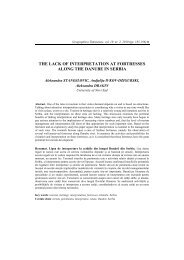
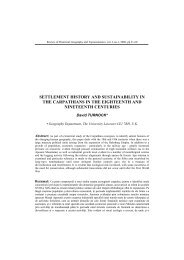
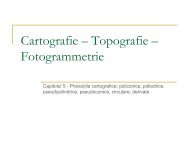
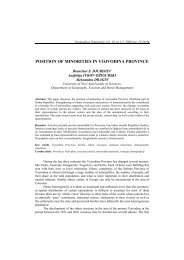
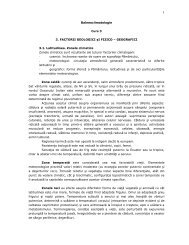
![in Romanian [pdf]](https://img.yumpu.com/51065862/1/184x260/in-romanian-pdf.jpg?quality=85)
